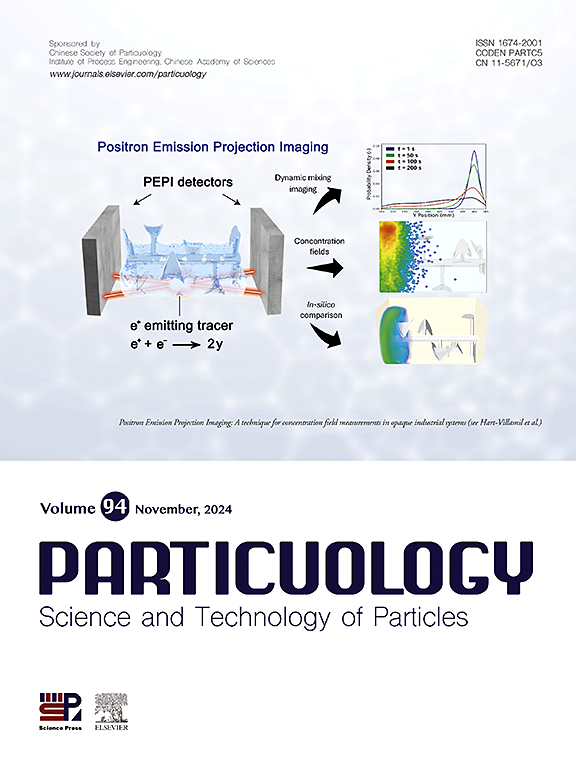Three-dimensional CFD-DEM investigation of dynamic characteristics of biomass particles in a conical spouted bed
IF 4.1
2区 材料科学
Q2 ENGINEERING, CHEMICAL
引用次数: 0
Abstract
A numerical investigation of the three-dimensional conical spouted bed was conducted using CFD coupled with discrete element method to systematically analyze particle-gas flow patterns, bubble volume fluctuations, and fountain characteristics. Moreover, the impact of conical angles on dynamic characteristics is demonstrated under varying gas inlet velocity and particle diameter. Firstly, the simulation result shows that increasing the conical angle is advantageous for enhancing both y-direction and angular velocities of particles, while the impact of this angle varies with inlet velocity and particle diameter. The great inlet velocity and particle diameter significantly enhance the voidage, while the larger conical angle promotes the uniform radial particle distribution. Besides, smaller conical angle and medium inlet velocity is prone to result in the higher frequency and amplitude for the fluctuations of particle height. Meanwhile, enlarging the conical angle results in a shift of the fountain frequency from high to low when the particle size is small. The conical angle plays a crucial role in determining bubble behavior under the condition of medium velocity and small diameter. Besides, the fine particle and small conical angle are prone to cause the noticeable main frequencies.

锥形喷流床中生物质颗粒动态特性的三维CFD-DEM研究
采用CFD与离散元法相结合的方法对三维锥形喷流床进行数值模拟,系统分析了颗粒-气体流动模式、气泡体积波动和喷泉特性。此外,在不同的入口速度和颗粒直径下,锥角对动态特性的影响也得到了验证。仿真结果表明:增大锥角有利于提高颗粒的y向速度和角速度,锥角的影响随入口速度和颗粒直径的不同而不同;较大的入口速度和颗粒直径显著增大了孔隙度,较大的锥角有利于颗粒径向均匀分布。此外,较小的锥角和中等的进口速度容易导致颗粒高度波动的频率和幅度更高。同时,增大锥角会使射流频率在粒径较小时由高向低变化。在中速小直径条件下,锥形角对气泡的行为起着至关重要的作用。此外,细颗粒和小锥角容易引起明显的主频率。
本文章由计算机程序翻译,如有差异,请以英文原文为准。
求助全文
约1分钟内获得全文
求助全文
来源期刊

Particuology
工程技术-材料科学:综合
CiteScore
6.70
自引率
2.90%
发文量
1730
审稿时长
32 days
期刊介绍:
The word ‘particuology’ was coined to parallel the discipline for the science and technology of particles.
Particuology is an interdisciplinary journal that publishes frontier research articles and critical reviews on the discovery, formulation and engineering of particulate materials, processes and systems. It especially welcomes contributions utilising advanced theoretical, modelling and measurement methods to enable the discovery and creation of new particulate materials, and the manufacturing of functional particulate-based products, such as sensors.
Papers are handled by Thematic Editors who oversee contributions from specific subject fields. These fields are classified into: Particle Synthesis and Modification; Particle Characterization and Measurement; Granular Systems and Bulk Solids Technology; Fluidization and Particle-Fluid Systems; Aerosols; and Applications of Particle Technology.
Key topics concerning the creation and processing of particulates include:
-Modelling and simulation of particle formation, collective behaviour of particles and systems for particle production over a broad spectrum of length scales
-Mining of experimental data for particle synthesis and surface properties to facilitate the creation of new materials and processes
-Particle design and preparation including controlled response and sensing functionalities in formation, delivery systems and biological systems, etc.
-Experimental and computational methods for visualization and analysis of particulate system.
These topics are broadly relevant to the production of materials, pharmaceuticals and food, and to the conversion of energy resources to fuels and protection of the environment.
 求助内容:
求助内容: 应助结果提醒方式:
应助结果提醒方式:


